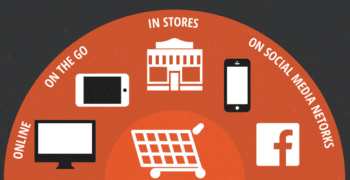That seamless experience which allow you to buy your favourite product, either from a brick & mortar store or an online store, from your store on MG Road to a Mall at the High Street, from a mobile app to a website.. You must be OMNI-PRESENT.. “Omni” is a Latin word which means “everywhere”. “Omni Channel” means ensuring your presence is “EVERYWHERE”.
When online retailers like Flipkart, Amazon, Snapdeal etc. started selling products online, the offline brick & mortar retailers considered it as a threat to their business. In my viewpoint, Flipkart, Amazon & Snapdeal were creating market places wherein even a single brick & mortar store owner could register & sell his products to the world. Never in his life can he imagine his store catering to millions of users across the world. Now, do you call this an Opportunity or a Threat! The call is yours.
Consumers expect brick-and-mortar stores to keep up, offering the same kind of integration in the shopping experience. They expect to be able to order items online, have them shipped to their house and return them in the store – a seamless experience between online and brick-and-mortar. Retailers must make sure that they meet these expectations, because if they don’t, shoppers can easily find another store that does. This seamless shopping experience is called omnichannel retailing.
Online Market Places & Offline Brick and Mortar Stores are like two sides of the same coin. Their modus operandi is diverse but the aim is the same, “Making more Sales”. Any brand looking at national/ international expansion must consider each and every channel that reaches out to the customer & ensure their significant presence on every channel in every way.
In the past, retailers have asked customers for their email address and zip code at the point of sale. However, they have no way of knowing which customers they have already asked, so they ask every customer every time – which can become bothersome. Instead, omnichannel strategies allow customers to enter their own information at their own will, which they are often more comfortable with.
For example, in-store kiosks allow customers to enter their email address rather than giving it to the cashier. Also, online stores and social media pages provide outlets for retailers to collect customer information in a less aggressive way, like simply inviting them to sign up for email alerts. They can choose to give their first and/or last name in addition to their email address, allowing retailers to send personalized emails.
In addition to name and email address, retailers can gain insight into what their customers have been shopping for online. With this information, they can make specific offers about customers’ favorite products. For example: “Dear Mrs. Gupta, We’ve noticed you have been looking for jeans lately. We would like to offer you 30 percent off of your next pair! Enter the promotion code ‘JEANS’ to redeem your exclusive offer.” This provides them with even more motivation to make a purchase.
With omnichannel retailing in place, shoppers can make purchases from wherever they please. It gives retailers inventory visibility and availability in the customer’s preferred channel. For customers, shopping is more convenient than ever and for retailers, there are more selling opportunities than ever. Shoppers have a wider selection and multiple means of accessing that selection. Here are a few examples of how retailers can leverage the omnichannel:
Online ordering: For example, a shopper who is stuck up in night shift, can browse her gym shoes and track pants online instead of having to going to the stores on her weekly off. She can order items straight from the store’s website and have them shipped to her house. You can offer style tips and size guides for exceptional online customer service.
Encouraged showrooming: Ever found the perfect pair of jeans only to realize there weren’t any left in your size? Omnichannel retailing allows customers to browse items in the store that may be of limited quantity and then shop for additional size and color options online. That way, they can see the item and try it on before purchasing it online. They can either have the item shipped and delivered to their house or shipped to the store for pick up. Retailers could also set up a kiosk, so customers can place an order for their preferred size and color while they are still in the store.
Social media sharing: Posting products and gift ideas on your social media profiles allows users to send them to their friends and share them on their own pages. Users can give opinions and recommendations to their friends, allowing word of your products to spread. Offering coupons and deals on your social media profiles will inspire users to visit your online store to redeem their exclusive offer.
The omnichannel is a beautiful thing. It allows retailers to get closer to their customers and make customized offers. It allows customers to enjoy the convenience of their preferred channel, a wider selection of items and a wealth of buying opportunities. It blurs the lines between online, brick-and-mortar, smartphones and social media for a five-star seamless shopping experience.
To know more about “How you can adopt an Omni-Channel approach?” get in touch with YRC Business Experts on [email protected]
YRC Related Articles: How to Write SOPs for Marketing?, 6 Ways To Grow Your Business, How to Start a Retail Business in India, Business Expansion Plan for Small Entrepreneurs, Six Steps to Writing a Great SOP for Retail, How to write SOPs for an Apparel Brand?, How to Develop SOPs for Quick Service Restaurant?, How to write SOPs for Furniture Showroom
Author Bio











